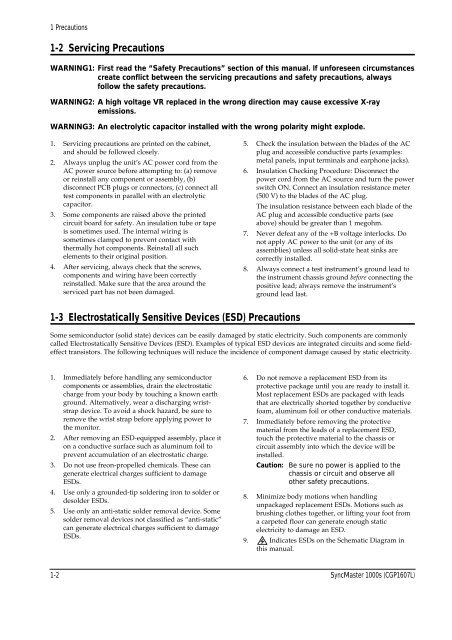Manual - Maintenance Electronique / Monitors Service Center
Manual - Maintenance Electronique / Monitors Service Center
Manual - Maintenance Electronique / Monitors Service Center
You also want an ePaper? Increase the reach of your titles
YUMPU automatically turns print PDFs into web optimized ePapers that Google loves.
1 Precautions<br />
1-2 Servicing Precautions<br />
WARNING1: First read the “Safety Precautions” section of this manual. If unforeseen circumstances<br />
create conflict between the servicing precautions and safety precautions, always<br />
follow the safety precautions.<br />
WARNING2: A high voltage VR replaced in the wrong direction may cause excessive X-ray<br />
emissions.<br />
WARNING3: An electrolytic capacitor installed with the wrong polarity might explode.<br />
1. Servicing precautions are printed on the cabinet,<br />
and should be followed closely.<br />
2. Always unplug the unit’s AC power cord from the<br />
AC power source before attempting to: (a) remove<br />
or reinstall any component or assembly, (b)<br />
disconnect PCB plugs or connectors, (c) connect all<br />
test components in parallel with an electrolytic<br />
capacitor.<br />
3. Some components are raised above the printed<br />
circuit board for safety. An insulation tube or tape<br />
is sometimes used. The internal wiring is<br />
sometimes clamped to prevent contact with<br />
thermally hot components. Reinstall all such<br />
elements to their original position.<br />
4. After servicing, always check that the screws,<br />
components and wiring have been correctly<br />
reinstalled. Make sure that the area around the<br />
serviced part has not been damaged.<br />
1-3 Electrostatically Sensitive Devices (ESD) Precautions<br />
1. Immediately before handling any semiconductor<br />
components or assemblies, drain the electrostatic<br />
charge from your body by touching a known earth<br />
ground. Alternatively, wear a discharging wriststrap<br />
device. To avoid a shock hazard, be sure to<br />
remove the wrist strap before applying power to<br />
the monitor.<br />
2. After removing an ESD-equipped assembly, place it<br />
on a conductive surface such as aluminum foil to<br />
prevent accumulation of an electrostatic charge.<br />
3. Do not use freon-propelled chemicals. These can<br />
generate electrical charges sufficient to damage<br />
ESDs.<br />
4. Use only a grounded-tip soldering iron to solder or<br />
desolder ESDs.<br />
5. Use only an anti-static solder removal device. Some<br />
solder removal devices not classified as “anti-static”<br />
can generate electrical charges sufficient to damage<br />
ESDs.<br />
5. Check the insulation between the blades of the AC<br />
plug and accessible conductive parts (examples:<br />
metal panels, input terminals and earphone jacks).<br />
6. Insulation Checking Procedure: Disconnect the<br />
power cord from the AC source and turn the power<br />
switch ON. Connect an insulation resistance meter<br />
(500 V) to the blades of the AC plug.<br />
The insulation resistance between each blade of the<br />
AC plug and accessible conductive parts (see<br />
above) should be greater than 1 megohm.<br />
7. Never defeat any of the +B voltage interlocks. Do<br />
not apply AC power to the unit (or any of its<br />
assemblies) unless all solid-state heat sinks are<br />
correctly installed.<br />
8. Always connect a test instrument’s ground lead to<br />
the instrument chassis ground before connecting the<br />
positive lead; always remove the instrument’s<br />
ground lead last.<br />
Some semiconductor (solid state) devices can be easily damaged by static electricity. Such components are commonly<br />
called Electrostatically Sensitive Devices (ESD). Examples of typical ESD devices are integrated circuits and some fieldeffect<br />
transistors. The following techniques will reduce the incidence of component damage caused by static electricity.<br />
6. Do not remove a replacement ESD from its<br />
protective package until you are ready to install it.<br />
Most replacement ESDs are packaged with leads<br />
that are electrically shorted together by conductive<br />
foam, aluminum foil or other conductive materials.<br />
7. Immediately before removing the protective<br />
material from the leads of a replacement ESD,<br />
touch the protective material to the chassis or<br />
circuit assembly into which the device will be<br />
installed.<br />
Caution: Be sure no power is applied to the<br />
chassis or circuit and observe all<br />
other safety precautions.<br />
8. Minimize body motions when handling<br />
unpackaged replacement ESDs. Motions such as<br />
brushing clothes together, or lifting your foot from<br />
a carpeted floor can generate enough static<br />
electricity to damage an ESD.<br />
9. Indicates ESDs on the Schematic Diagram in<br />
this manual.<br />
1-2 SyncMaster 1000s (CGP1607L)


